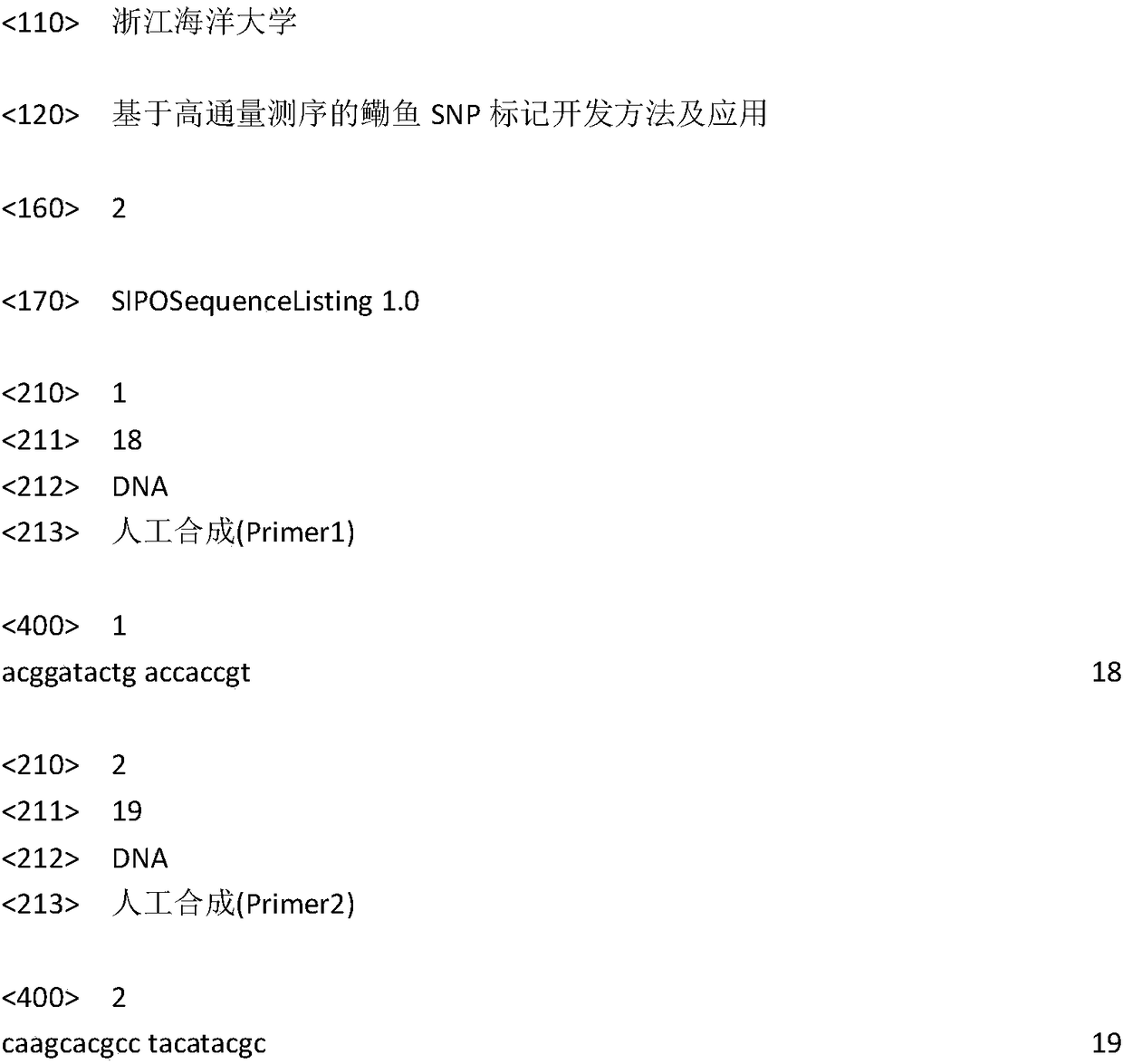High-throughput sequencing-based ilisha elongate SNP (singular nucleotide polymorphism) marker developing method and application thereof
A high-throughput, sequencing technology, applied in the field of molecular biology, can solve the problems of complex sequencing procedures and low purity of target DNA, achieve consistent amplification efficiency, reduce library construction costs, and high screening accuracy.
- Summary
- Abstract
- Description
- Claims
- Application Information
AI Technical Summary
Problems solved by technology
Method used
Image
Examples
Embodiment 1
[0031] A high-throughput sequencing-based method for the development of SNP markers in squid, comprising the following steps:
[0032] Genomic DNA extraction: Mince the muscle or fin ray tissue samples of the carp and place them in extraction solution I: 70ml of Tris-HCl and disodium hydrogen phosphate with a concentration of 120mM, 0.3g of fatty alcohol ether ammonium sulfate, and 30ml of chlorine with a concentration of 120mM Sodium chloride solution; add 0.5 μg plasmid DNA and 0.1 μg chitin, freeze and thaw 2-3 times, the freezing temperature is -166°C, the melting temperature is 50°C, centrifuge, collect the supernatant and add extract II: 10ml Tris-HCl with a concentration of 100mM and disodium hydrogen phosphate and 30ml of cationic polyacrylamide with a concentration of 0.5ppm were mixed upside down, centrifuged to produce a white precipitate, and the precipitate was washed to obtain a DNA sample for use; circular DNA and chitin The special existence, on the one hand, c...
Embodiment 2
[0039] A high-throughput sequencing-based method for the development of SNP markers in squid, comprising the following steps:
[0040] Genomic DNA extraction: Mince the muscle or fin ray tissue samples of the carp and place them in extraction solution I: 70ml of Tris-HCl and disodium hydrogen phosphate with a concentration of 150mM, 0.5g of fatty alcohol ether ammonium sulfate, and 30ml of chlorine with a concentration of 130mM Sodium chloride solution; add 0.5 μg plasmid DNA and 0.1 μg chitin, freeze and thaw 2-3 times, the freezing temperature is -166°C, the melting temperature is 50°C, centrifuge, collect the supernatant and add extract II: 10ml Tris-HCl with a concentration of 100mM and disodium hydrogen phosphate and 30ml of cationic polyacrylamide with a concentration of 1.6ppm were mixed by inversion, centrifuged to produce a white precipitate, and the precipitate was washed to obtain a DNA sample for use;
[0041] RAD library construction and high-throughput sequencing...
Embodiment 3
[0047] In the process of RAD library construction and high-throughput sequencing, chitin fluid was added during the PCR amplification system, the mass percentage of chitin was 0.16%, and the solvent was L-amino acid ethyl ester; the rest were exactly the same as in Example 2; The special existence of chitin fluid has a strong adsorption force to DNA, which can improve the success rate of PCR. At the same time, chitin fluid is composed of many tiny spheres, which can wrap the reaction system, so that the PCR amplification reaction can be completed in a small independent space. , so as to improve the reaction sensitivity of PCR amplification, make the reaction more sufficient, and improve the PCR amplification effect of trace DNA; in addition, chitin fluid can increase the boiling point of the reaction system so that the system buffer is not easy to evaporate, reducing the amount of time in the PCR amplification process. The amount of reagents used, thereby reducing the cost of t...
PUM
 Login to View More
Login to View More Abstract
Description
Claims
Application Information
 Login to View More
Login to View More - R&D
- Intellectual Property
- Life Sciences
- Materials
- Tech Scout
- Unparalleled Data Quality
- Higher Quality Content
- 60% Fewer Hallucinations
Browse by: Latest US Patents, China's latest patents, Technical Efficacy Thesaurus, Application Domain, Technology Topic, Popular Technical Reports.
© 2025 PatSnap. All rights reserved.Legal|Privacy policy|Modern Slavery Act Transparency Statement|Sitemap|About US| Contact US: help@patsnap.com


